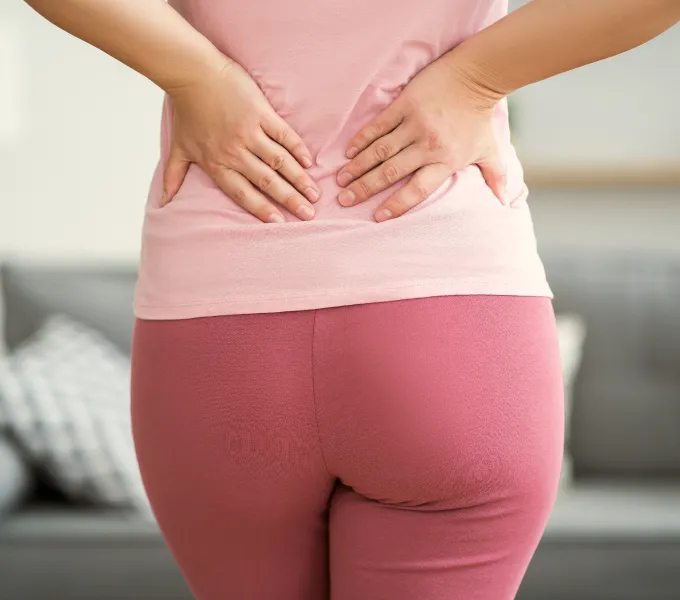
Pain in the Butt? 10 Ways to Relieve Postpartum Tailbone Pain
There's nothing like serious coccyx pain to make you keenly aware of how many hours you spend sitting. Whether you're sitting down to feed your baby, get some work done, drive to the store, or (in those rare and wonderful moments) relax in front of your favorite trashy TV show, your tailbone gets a whole lot of use.
In medical terms, tailbone pain is known as coccydynia, aka pain at the coccyx, which is the small bone at the very bottom of your spine. This pain tends to get worse with activities like sitting down, standing up, prolonged sitting, having a bowel movement, or having sex. It can be caused by trauma to the coccyx, like a fall or an instrument-assisted vaginal delivery, prolonged sitting on a hard surface, or by some other underlying health condition.
Ignoring coccydynia (or any kind of pain) is never a good idea, especially postpartum, when it can make it harder or impossible to take care of your newborn. See a doctor ASAP so they can order an x-ray to rule out a potential fracture and refer you to a pelvic floor physical therapist for treatment.
In the meantime, here are 10 ways that you can start to relieve tailbone pain postpartum.
1. Cushion your coccyx with the right pillow.
If your tailbone hurts, continuing to sit on it is likely to increase your pain and delay healing. Consider purchasing a coccyx pillow specifically designed to offload your weight from your tailbone while sitting. (Note that a coccyx pillow is different from a "donut" pillow, which won't be as effective for tailbone pain.)
It can be difficult to consistently use a pillow if you have to drag it around with you from place to place (especially if one arm is already occupied with a newborn baby). So consider buying a few coccyx pillows, if you can, and put them everywhere you typically sit: in the car, at your desk, in your nursing chair, etc.
2. Ice your coccyx for 10-20 minutes.
To reduce inflammation, apply a cold pack or ice to your tailbone for 10-20 minutes following activities that increase pain. At the very least, aim to ice your tailbone once a day. Be sure to have a layer of clothing (or a clean, thin dish towel) between your skin and the ice, to make it tolerable.
You don't want to sit directly on the ice pack because it will increase weight at the tailbone and cause more pain. Instead, lie on your back with the ice pack underneath you, or on your side with the pack draped over your pelvis or leaning against your tailbone.
3. Massage your glutes to stimulate blood flow.
- Place a large foam roller on the floor and sit on it, making sure to lean your weight onto your left or right hip and glute (not your tailbone).
- Bring your arms behind you and place your hands on the ground for balance.
- Cross one foot over your knee in a figure 4 position.
- Using your arms to move you, rock forwards and backwards over the roller. Tip: You can vary the amount of pressure on your glute by changing the amount of weight you place through your arms.
- When you find a particularly tender area, hold this position, increasing the pressure through the roller.
Note: This should not be painful but may be uncomfortable. If pain, numbness, or tingling occur while doing this exercise, stop and reach out to your primary care provider or physical therapist for guidance.
4. Inhale into your pelvic floor to reduce tension on your tailbone.
- Start lying comfortably on your back.
- Inhale deeply, allowing air to fill your low belly and all the way down into your pelvic floor. Allow your pelvic floor to relax and lengthen down, away from your trunk.
- On exhale, allow your pelvic floor to return to its resting/neutral position.
Note: While it helps to begin by lying down, you can practice this breathing technique in any position. Try to do this before bowel movements and any time you feel increased tailbone pain to reduce tension at your pelvic floor.
5. Keep your bowels moving to ease pressure on your coccyx.
Be sure to drink plenty of water, have adequate fiber intake, and remain active in order to avoid constipation. Having bowel movements with tailbone pain can be tricky — the last thing you need is a hard, stubborn stool adding to your discomfort.
If you suffer from constipation and are currently nursing, reach out to your OB for safe over-the-counter strategies to improve your bowel movement regularity and consistency.
6. Stretch your pelvic floor to instantly relieve coccyx pain.
- Stand with your feet hip-distance apart and your toes angled slightly outward.
- Inhale as you relax your belly, letting it fill with air.
- Exhale, and draw your belly button in toward your spine as you squat down, letting your knees rotate outward and away from your center. Your heels may lift slightly off the ground. Tip: For added stability, place a yoga block under your glutes, or hold onto a stable surface with one hand.
- Hold the squat and breathe as you focus on relaxing the muscles in your pelvic floor and the surrounding areas.
Note: If you experience pain with getting in and out of this stretch or during this stretch, stop this exercise.
7. Stretch your hips to reduce pulling and tension on your coccyx.
- Lay down onto your back with your knees bent and feet flat on the ground.
- Cross one leg over your opposite knee, placing the outside of your ankle just above the knee.
- For a deeper stretch, interlace your fingers behind the thigh of your stabilizing leg, and pull your thigh in towards you, lifting the foot off the ground. Tip: Keep your shoulders relaxed and away from your ears for the duration of the stretch.
- Hold the position and breathe. Where you'll feel it: In your glute.
Note: Stop if this causes pain, also do not make sudden movements when releasing this stretch, be slow and gentle to return to neutral.
8. Move your body gently to help lower inflammation.
- First, lower yourself down onto your hands and knees.
- Start with side bending by imagining you are trying to touch your shoulder and your hip together, then arch your back down towards the ground, side bend to the other side, then curve your back upwards in a hunch. Tip: Imagine you are drawing a circle with your belly button.
Note: Stop if this causes pain. Also, avoid sudden movements when releasing this stretch — be slow and gentle to return to neutral.
9. Strengthen your glutes to provide support to your coccyx.
- Lie on your back with both knees bent. Your feet are flat and hip distance apart.
- Exhale, and draw your belly in to engage your core before the movement. Keep your core engaged as you push into your heels, and lift your hips off the ground, then return back down to the starting position. Tip: Imagine you are balancing a glass of water on your lower belly as you perform the movement- This will help keep your core working to stabilize your pelvis.
- Inhale to reset, the exhale and repeat.
Note: This should not be painful. If this causes pain, reduce how far you bring your bottom off the floor or how much force you generate and try again.
10. Do some kegels to boost core strength and stability.
- Start by sitting upright in a comfortable position with your feet flat on the ground.
- Inhale through your nose, relaxing your pelvic floor as you fill your belly with air.
- As you begin to exhale out of your mouth, draw the belly back towards your spine and contract and lift your pelvic floor muscles, holding the contraction for the duration of your exhale.
Note: If symptoms increase with doing kegels, stop and reach out to a pelvic floor physical therapist for a program that is tailored to fit your needs.




